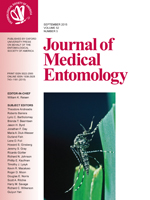Chagas disease is a zoonosis transmitted to man by blood-sucking triatomine bugs found in the Americas. Triatoma infestans (Klug, 1834) is the main vector of Chagas' disease in Argentina. The control of this illness relies heavily on vector control through the use of insecticide. However, resistance to pyrethroid insecticides associated with ineffective field treatments has been increasingly reported in T. infestans from Argentina and Bolivia. There are few reports on the expression and causes of resistance in eggs of resistant populations, and even fewer studies on insecticide resistance throughout embryonic development. In this study, we explore the biochemical and molecular mechanisms potentially associated with the deltamethrin resistance assessed in the developing eggs of the Argentinean (Campo Largo) and Bolivian (Entre Ríos) T. infestans populations.
We found measurable activity of monooxigenases and pyrethroid esterases throughout embryonic development. The pyrethroid esterase activity grew steadily throughout development in all the studied populations and was highest in eggs 12 d old. Mean enzyme activity increased from 13.6 to 16.3 and 22.2 picomol 7-hydroxycoumarin/min (7-OHC) in eggs of 4-, 7-, and 12 d old from the susceptible reference bug colony. Mean activity of resistant populations increased from 16.0 to 25.9 picomol 7-OHC/min in eggs of 4- to 12 d old in Entre Ríos population, and from 15.9 to 28.9 picomol 7-OHC/min in Campo Largo population. Molecular analysis of susceptible and resistant developing eggs detected L1014F mutation in both resistant populations, but no L925I mutation was found in any of the studied populations.
Higher esterase activity and L1014F presence justify the resistance to pyrethroid throughout developing eggs of both studied T. infestans populations. The description of resistance profiles including resistance mechanisms involved will allow a rational design of campaigns for the control of Chagas disease transmission.





